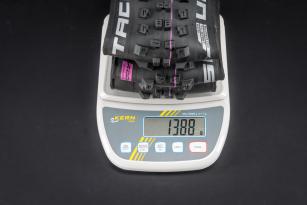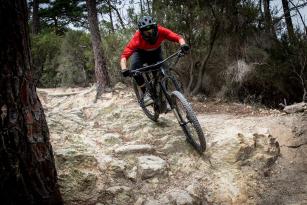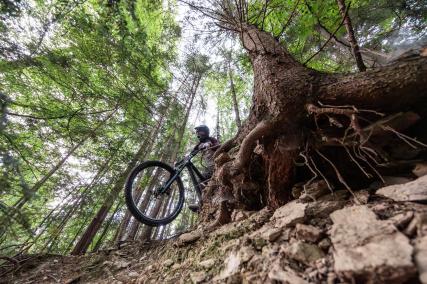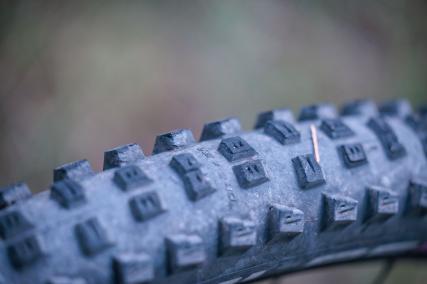
Review: Schwalbe Tacky Chan 2023
16.11.23 09:03 612023-11-16T09:03:00+01:00Text: Ralf Hauser (translated by AI)Photos: Erwin HaidenBringing a new tire design to the market is always a big step for a tire manufacturer, as it must assert itself against strong competition from both its own and other companies. Already introduced with the first riding impression, we have worn down the profile of the Tacky Chan over several hundred kilometers in the past few months to see if the newcomer passes the test.16.11.23 09:03 4242023-11-16T09:03:00+01:00Review: Schwalbe Tacky Chan 2023
16.11.23 09:03 4242023-11-16T09:03:00+01:00 Ralf Hauser (translated by AI) Erwin HaidenBringing a new tire design to the market is always a big step for a tire manufacturer, as it must assert itself against strong competition from both its own and other companies. Already introduced with the first riding impression, we have worn down the profile of the Tacky Chan over several hundred kilometers in the past few months to see if the newcomer passes the test.16.11.23 09:03 4242023-11-16T09:03:00+01:00After exploring the origins and details of the Schwalbe Tacky Chan in our First Ride article, this review focuses on the practical experiences gathered.
Commendable by the way: Schwalbe's efforts to integrate more and more sustainable projects along with social commitment into their production. The Tacky Chan uses fairly traded rubber - an initiative that was launched by Schwalbe itself with partners.
Mounting the tire onto the rim went smoothly throughout. On a DT Swiss FR 1500 wheelset, the tire slipped on without resistance and with a regular floor pump, it seated cleanly onto the rim shoulder.
At first glance, the tire looks quite narrow, but upon measuring, it meets its width specification fairly. The outermost points of the side knobs showed 62.33 mm after 24 h at 3 bar air pressure. This confirms the size of the stated ETRTO dimension specification of 62-584 or 62-622, or 2.4", quite exactly. The widest distance of the tire wall measured 58 mm.
Our test models weighed 1,388 g for the 29 x 2.4" and 1,266 g for the 27.5 x 2.4" size in Super DH and Ultra Soft versions.
On the Trail of Clues
Whether or not one likes the name of Schwalbe's latest gravity tire is certainly up for debate. But like so much else, naming is a matter of taste and fortunately says absolutely nothing about its capabilities.
What is much more important is to find the limits of the tire, so that sleek cornering does not end with a belly flop in the bushes. Finding those of the Tacky Chan is not that easy. Good! Because with a tire where maximum traction is the goal, that's probably the ultimate aim.
The Tacky Chan feels extremely balanced even at the limit, but I must honestly say it was hard to find out when this limit begins. Especially the side knobs cling stubbornly to the ground.
The newcomer has a talent for pursuing a chosen line with determination. Although there is a clearly visible channel between the shoulder knobs and the center knobs, it does not feel like the tire unpleasantly tips back and forth between the two areas when tilted. This could be due, on the one hand, to the fact that every fourth center knob forms a kind of bridge between the sections, and on the other hand, to the evenly rounded shape of the tire if you look at its profile in cross-section.
With my usual riding style, which is not on the racing level of today's professional riders but still lies above that of the average biker, especially in technically demanding situations, it was fascinating to feel how much control the Tacky Chan could offer on the most varied terrains – from deserted Swiss Alpine trails to sandy single tracks of the Ligurian coast.
In my opinion, while the profile of the Magic Mary struggles especially with loose gravel on hard surfaces, the Tacky Chan – even or especially – masters this challenge good-naturedly and calmly. Those who like to ride on not perfectly maintained bike park or flow trails will particularly appreciate this characteristic. Not once, under the most varied conditions, did I ever have to ask myself whether my tire was the right choice for the trail ahead. As someone who fundamentally expects their bike to deliver reliable performance, no matter what speed or route one throws at it – without having to fiddle with settings or components before the ride – this is a criterion of high value.
Should the tire - rarely, but still - slip away at the limit, for example on a layer of loose gravel on a hard surface, it breaks away quite quickly, but then recovers as soon as it hits a small area with more grip.
During the entire test period, there was no case where the tire unexpectedly lost ground contact and the bike slid uncontrollably out from under me.
Even on wet and soft forest soil, the Tacky Chan – at least with Ultra Soft rubber compound – reliably holds its course.
If I had to look for a weakness, after several months the only thing that comes to mind is the situation on smooth polished stones and roots when wet, where the tire, despite the softest rubber compound available from Schwalbe, does not earn absolute top marks.
In deep gravel – a situation that does not occur too often in the wild – the Tacky Chan also does not stand out. Here, the tread depth is probably a bit too shallow. However, the tire did not feel unpleasantly floaty either.
The only test surface that I have not encountered on the trails or actively searched for are deep muddy conditions. Accordingly, I prefer to refrain from guessing how the Tacky Chan would perform under such conditions.
Although the height of the central knobs is limited, the tire has high braking traction, which can decelerate the bike very well on different surfaces. In return, the Tacky Chan also surprised me with good grip when climbing uphill, even on steep sections with the e-bike where the grip did not unexpectedly give out.
Now that I am used to only riding the softest rubber compounds on my bikes, I do not perceive the Ultra Soft version from Schwalbe as a rolling resistance anchor. Schwalbe's goal of tuning the profile for fast rolling performance (achieved in part through the ramps on the central knobs) seems to have been successful.
Even on a regular enduro bike, one does not feel like they are pedaling through molasses, and at least for the front tire, I would not hesitate long to prioritize the highest possible grip over higher durability or faster rolling performance. As a rear tire for enduro & co., one will probably think about it; likewise on the e-bike, although even with regular rides one will probably get through the summer with one set, as long as one does not value perfect edge shape all year round. In the end, the wallet will probably, as always, have a bit of a say in how much one values better grip.
It is interesting to note that the sidewalls of our test model with the Super Downhill casing feel considerably more adaptable than those of other tire models from Schwalbe. In my test repertoire, there are even Super Gravity casings from other Schwalbe models that feel stiffer (although there seem to be differences between various tire models here as well). Personally, since my weight is on the lighter side, I am extremely pleased with this development, as the tire can adapt more easily to the terrain, especially at low air pressure. However, it does not feel spongy because of this.
After discussions with colleagues who are significantly heavier, it turned out that they also had no problems with the more compliant sidewalls and could not detect any differences in puncture resistance.
In terms of the durability of the Ultra Soft rubber compound, I was pleasantly surprised. Even after a longer period of use of almost 900 km, the edges showed very little wear on the front tire, and the notches on the tread remained clearly defined.
As a rear tire with partial use on an e-bike, the knobs were worn down to about half their length after this distance. Naturally, in this condition, the braking power and drive traction began to suffer significantly. The side knobs also showed some signs of wear on the edges but still hooked into corners reliably.
Had the tire been mounted exclusively as a rear tire on a DH bike, it is likely that it would have lost a bit less rubber.

 was spooled as a rear tire on an e-bike. Accordingly, the middle knobs especially show signs of wear after the test period. Despite this, the cornering traction was still at a high level.was spooled as a rear tire on an e-bike. Accordingly, the middle knobs especially show signs of wear after the test period. Despite this, the cornering traction was still at a high level.
was spooled as a rear tire on an e-bike. Accordingly, the middle knobs especially show signs of wear after the test period. Despite this, the cornering traction was still at a high level.was spooled as a rear tire on an e-bike. Accordingly, the middle knobs especially show signs of wear after the test period. Despite this, the cornering traction was still at a high level.
The sidewalls, especially on the rear wheel, showed some cuts and scratches, which, however, only slightly damaged the outermost layer. Neither sealant nor air has leaked out at any point.
After numerous descents through rough rock gardens and loose gravel, this is a pleasing result. There were no torn knobs either, but based on my experience, I have never had such issues with Schwalbe before.
It's good that Schwalbe offers the Ultra Soft rubber compound right from the start also with Super Trail and Super Gravity carcass. This means that the Tacky Chan should be just as interesting for enduro riders as it is for downhillers – and for riders who want to use inserts.
As of November 2023, the Tacky Chan is available in Addix Ultra Soft and Soft in the carcasses Super Downhill, Super Gravity, and Super Trail in 29 x 2.4" and 27.5 x 2.4". The recommended retail price ranges from €68.90 to €74.90 depending on the version.
Conclusion
| Schwalbe Tacky Chan | |
|---|---|
| Model Year: | 2023 |
| Test Duration: | 4 Months / 900 km |
| Price: | € 68,90 to 74,90 RRP |
| + | Especially on hard ground, excellent grip |
| + | Very good all-round properties |
| + | High braking traction |
| + | Precise tracking |
| + | Good rolling characteristics |
| + | Compliant sidewalls |
| o | Not an expert on wet, slick roots and rocks |
| BB-Verdict: | Grip master with the potential to establish itself in the league of the best. |
From an almost overwhelming number of tires on the market, there are a few that have taken a firm place in the hearts of various bikers. It may be a bit premature to judge, but the Tacky Chan certainly has the potential to rise to this illustrious list.
Of course, tastes vary and demand different riding styles and expectations of a tire's behavior in critical situations require a tire design in a variety of ways. Although the Tacky Chan has been fine-tuned by the development team for fast running and precise tracking, I do not want to deny its excellent all-round properties. It is only on smooth, wet roots and stones that I would not rate it as outstanding, although most tires reach their limits under these conditions. In all other situations, the tire conveys a very high level of control and steering precision, which gives a lot of confidence when chasing seconds.
It should be noted that this test refers exclusively to the Ultra Soft rubber compound. Naturally, one must assume that harder rubber compounds offer less grip on all surfaces, but with lower rolling resistance and higher durability.
To what extent the new profile is compatible with such properties will certainly become apparent in the coming months and years. After all, one can expect that the Tacky Chan will be found on numerous bikes as an original equipment component.


























